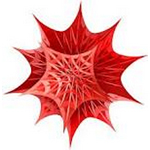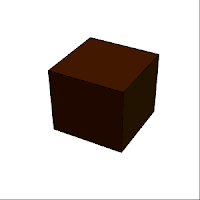TRANSCRIPT OF THE LECTURE ON ENZO VENTURELLY BY MARCO RAINÓ ON THE OCCASION OF THE CELEBRATION OF THE 150 YEARS OF ITALIAN NATIONAL UNITY.
I will talk about Enzo Venturelli. I am very happy to be able to discuss him with you tonight, for at least two reasons: the first reason is related to his representativeness. I always thought that Venturelli, even though he did not become very famous, could represent well those Italian thinkers and artists who gave Italy the chance to show a certain talent in Contemporary Arts. The second reason is linked to what I said before. The importance of Enzo Venturelli is strongly connected to his ability to act in the contemporary world, carrying on his projects while keeping an eye towards the future. So I believed that this kind of personality could suit very well an occasion like this, the celebration of 150 years of Italian national unity. He worked in his present, but always thinking of the future. So, I think that our nation, which sometimes is way too much obsequious of the past and diverted from the present, should take more care of the future. I have never met this man about whom I am talking here this evening, but at a certain point of our lives I felt closer to him. I hope you don’t mind if now I tell you a few biographical notes; they are useful to understand the rest of the story. In 1998, I was guest of a friend of mine, whose house is located on the area before the hill which leads to Cavoretto, a Turin neighbourhood. It was a beautiful place, surrounded by a lot of green areas, as often happens on the hills around Turin. There, the architecture of the buildings was very conventional, nothing really stood out. While watching the landscape, I saw something different from the rest, which was quite regular. It was not related to the natural environment; I watched more carefully and I noticed that it was a construction. It struck me like a meteorite; I didn’t bring any pictures with me tonight, so I hope I can be effective. The building was anchored to the soil, but it was like it was going to take flight. The house I was observing was built in 1953 by Enzo Venturelli for a special purchaser, the sculptor Alberto Mastroianni, who was quite famous in Turin and in Italy. The gate you entered to come in was designed by this sculptor. Alberto decided to buy a little plot of land on the hill, but it was so little that it was very difficult to find the correct proportion between the overall dimensions of the building and the landscape. Some people say that Mastroianni did not pay the land, but he promised the owner to carve his bust. We do not know if he kept the promise, but we are sure that Mastroianni was planning to move there not only his house, but also his studio. Despite this, he did not live for a long time in that house, he even neglected it for 15 years. After noticing this house, so different as the personality of his creator, I started to study Venturelli, but I didn’t find out much, because we know very few things about him and what was written about him, has not been preserved. I tried to go on, searching through the archives, but again I obtained nothing. I was stubborn and I thought that I could resort to the phone book. I found his number in Turin and called. A woman answered and that was the moment I was closer to him, because that woman was Venturelli’s wife. I introduced myself and, since I was very eager to know more about Venturelli’s way of planning, I asked for a meeting and she agreed. I met Piera Portino, his wife, three times here in Turin in their house in Corso Re Umberto. I am specifying the address because it is one of the most conventional neighbourhoods in Turin and it is quite strange that an unordinary man like Venturelli lived there. It is a beautiful area, full of elegant buildings but without the experimental mood which always was a feature of Venturelli as an architect. That was a normal house, but after meeting Piera Portino, I convinced myself that the construction on the Cavoretto hill was not an incident. It was part of a plan, it was a Venturelli’s manifesto. In the ‘40s and ‘50s, he began to formulate hypotheses for the city in the future, he projected himself in the near and far future, therefore he understood that there is a different way of doing architecture and thinking of a city. In 1960 he wrote a treaty titled “Urbanistica Spaziale” (Spatial Urban Planning) which now is very difficult to find. It was printed by the Turin publishing house Pozzo. In this book he put on paper all the visions he had of the future city coming from his present. This pamphlet is rich of irony and its contents are strongly connected to the European architecture, to the models proposed by Le Corbusier which were quite unusual not only in Turin, but in whole Italian scene. He wrote about Spatial Urban Planning, but also wrote the “Manifesto dell’Architettura Nucleare” (Manifesto of Nuclear Architecture). From that moment on, he created a lot of terminology and labels attached to his projects, all of them referring to the galaxy, the cosmos and mutants. This inclination to projecting himself in the future can already be found in his earlier plans and Mastroianni’s house and studio are an example. It seems to go beyond its actual location. On one side we find very edgy, daring structures, deep lights; it follows an horizontal trend, while on the other side the studio follows a vertical pattern. Venturelli was always ready to visit another dimension while being in his present. I believe (supported in this belief by what his wife told me) that Venturelli had an ambivalent personality. He lived in a conventional dimension, as highlighted when I mentioned his house, and he was very shy, he strayed away from society. At the same time he was also able to go beyond the boundaries of conventionality and to become (at least so it seemed) very different from his usual appearance. He also explored other forms of artistic expression such as painting. Late in his life, in the ‘70s, he put on canvas some visions which tell us of another world. Some of the titles of these paintings are “Big Bang”, “Mutant”, “Space Standard-Bearer”, “Traveller in Time”. In these works we find again those edgy geometries that the Mastroianni’s house highlighted so well. Venturelli didn’t work for public purchasers, since he was too eccentric for them. Only in one occasion, he worked for the City of Turin; in 1958 when the reptilarium had to be built in the local zoo. In this construction he restrained a bit his visionarity, but it was the first occasion in which he had a wider audience. As his wife told me, on the zoo opening, he had to stand beside the city mayor, but instead he disappeared. His wife found him only after two hours and he confirmed her that he was not able to meet the crowd. He didn’t love very much to travel and for this reason he refused many jobs and invitations abroad. He had not many friends in Turin, but those few whom he saw as friends were artists themselves; for example he was strongly related to the sculptor Mastroianni and to the painter Spazzapane. He was invited many times to give lectures in the USA, but he refused because he was too afraid to fly on airplanes. Only on one occasion, in 1958, he went to Detroit and people there tried to convince him to stay as lecturer at the local polytechnic, but he came back to Turin. He recalled me another man, the writer Salgari, who never moved from Turin, but was able to describe in his books countries very far away from him. The story of the connection between Venturelli and his time is quite peculiar: he perceived the difficulty to relate with his fellow citizens and the impossibility to realize his ideas, so he stopped planning and painting in the ‘80s. Since then, he read a lot and put together a big collection of books, now kept at the State Archive. It was moved there in order to be consulted by people as he stated in his last will. Maybe he stopped working in his late years because he had already told us everything that was necessary to be told. He died in 1996, two years before I found out about him. I remember with joy his wife, who welcomed me very warmly, even though I was still a student at that time. She showed enthusiasm for my interest in her husband.




































